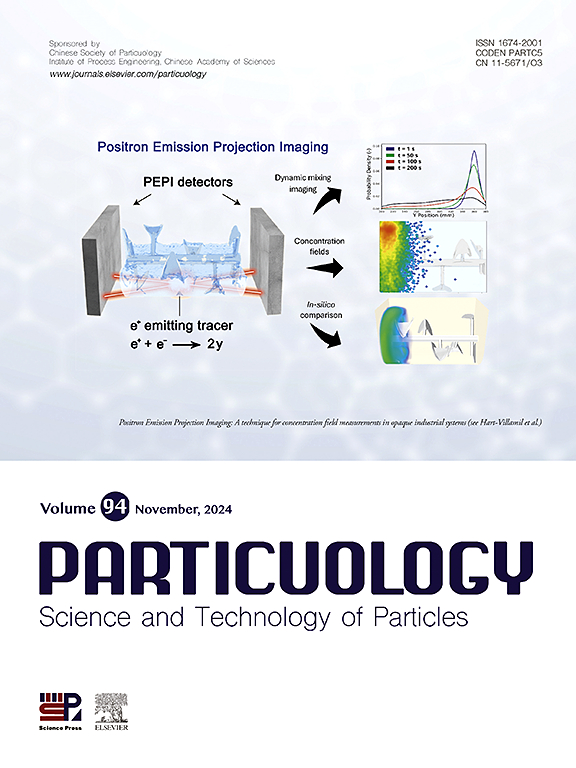Computational study of the effect of friction coefficients and particle shape on the repose angle and porosity of sinter piles
IF 4.3
2区 材料科学
Q2 ENGINEERING, CHEMICAL
引用次数: 0
Abstract
Shape has an undeniable impact on particle behaviour, and the shapes of naturally occurring granular matter are typically irregular. Computational studies of irregularly shaped particles are challenging but necessary to gain a better understanding of the flow of particulate matter. This study focuses on the behaviour of irregular sinter particles and applies the discrete element method to examine the effects of static and rolling friction coefficients and particle shape on the angle of repose and porosity of sinter piles. A three-dimensional model of an irregular sinter particle reconstructed by close-range photogrammetry served as the template for generating multi-sphere particles with varying numbers of sub-spheres (1, 3, 7, 22, and 135) and sphericity ranging from 1 to 0.69. Simulations of particle piles were conducted for a range of values of the coefficients of static and rolling friction. The results indicate that the angle of repose increases with static friction and also increases with rolling friction coefficient when it is lower than the static coefficient. The angle of repose shows clear dependence on particle shape, particularly for lower rolling friction coefficients. The friction coefficients for particles of five different shapes were individually determined through bulk calibration, and irregularly shaped particles in DEM were found to require lower friction coefficients. Porosity was marginally affected by the static and rolling friction coefficients for spherical particles, while non-spherical particles showed porosity increasing with the rolling friction coefficient. The relationship between particle sphericity and porosity was nonlinear: as sphericity decreases from 1.00 to 0.69, the porosity first decreases to a minimum and then increases. The findings confirmed that both friction and particle shape have a significant influence on the structure of sinter piles, with implications for material handling and processing in industrial applications.

摩擦系数和颗粒形状对烧结桩休止角和孔隙率影响的计算研究
形状对粒子的行为有着不可否认的影响,自然形成的颗粒物质的形状通常是不规则的。不规则形状颗粒的计算研究具有挑战性,但对于更好地理解颗粒物质的流动是必要的。本文主要研究了不规则烧结颗粒的行为,并应用离散元方法研究了静摩擦系数和滚动摩擦系数以及颗粒形状对烧结桩休止角和孔隙率的影响。通过近距离摄影测量重建不规则烧结颗粒的三维模型,作为模板生成具有不同亚球数(1、3、7、22、135),球度范围为1 ~ 0.69的多球颗粒。对颗粒桩静摩擦系数和滚动摩擦系数进行了数值模拟。结果表明:静摩擦时休止角增大,低于静摩擦系数时随滚动摩擦系数增大;休止角明显依赖于颗粒形状,特别是在较低的滚动摩擦系数下。通过体标定分别确定了5种不同形状颗粒的摩擦系数,发现DEM中形状不规则的颗粒所需的摩擦系数较低。球形颗粒的孔隙度受静态和滚动摩擦系数的影响不大,而非球形颗粒的孔隙度随滚动摩擦系数的增加而增加。颗粒球度与孔隙度之间呈非线性关系,随着球度从1.00减小到0.69,孔隙度先减小到最小,再增大。研究结果证实,摩擦和颗粒形状对烧结桩的结构有重大影响,这对工业应用中的材料处理和加工具有重要意义。
本文章由计算机程序翻译,如有差异,请以英文原文为准。
求助全文
约1分钟内获得全文
求助全文
来源期刊

Particuology
工程技术-材料科学:综合
CiteScore
6.70
自引率
2.90%
发文量
1730
审稿时长
32 days
期刊介绍:
The word ‘particuology’ was coined to parallel the discipline for the science and technology of particles.
Particuology is an interdisciplinary journal that publishes frontier research articles and critical reviews on the discovery, formulation and engineering of particulate materials, processes and systems. It especially welcomes contributions utilising advanced theoretical, modelling and measurement methods to enable the discovery and creation of new particulate materials, and the manufacturing of functional particulate-based products, such as sensors.
Papers are handled by Thematic Editors who oversee contributions from specific subject fields. These fields are classified into: Particle Synthesis and Modification; Particle Characterization and Measurement; Granular Systems and Bulk Solids Technology; Fluidization and Particle-Fluid Systems; Aerosols; and Applications of Particle Technology.
Key topics concerning the creation and processing of particulates include:
-Modelling and simulation of particle formation, collective behaviour of particles and systems for particle production over a broad spectrum of length scales
-Mining of experimental data for particle synthesis and surface properties to facilitate the creation of new materials and processes
-Particle design and preparation including controlled response and sensing functionalities in formation, delivery systems and biological systems, etc.
-Experimental and computational methods for visualization and analysis of particulate system.
These topics are broadly relevant to the production of materials, pharmaceuticals and food, and to the conversion of energy resources to fuels and protection of the environment.
 求助内容:
求助内容: 应助结果提醒方式:
应助结果提醒方式:


